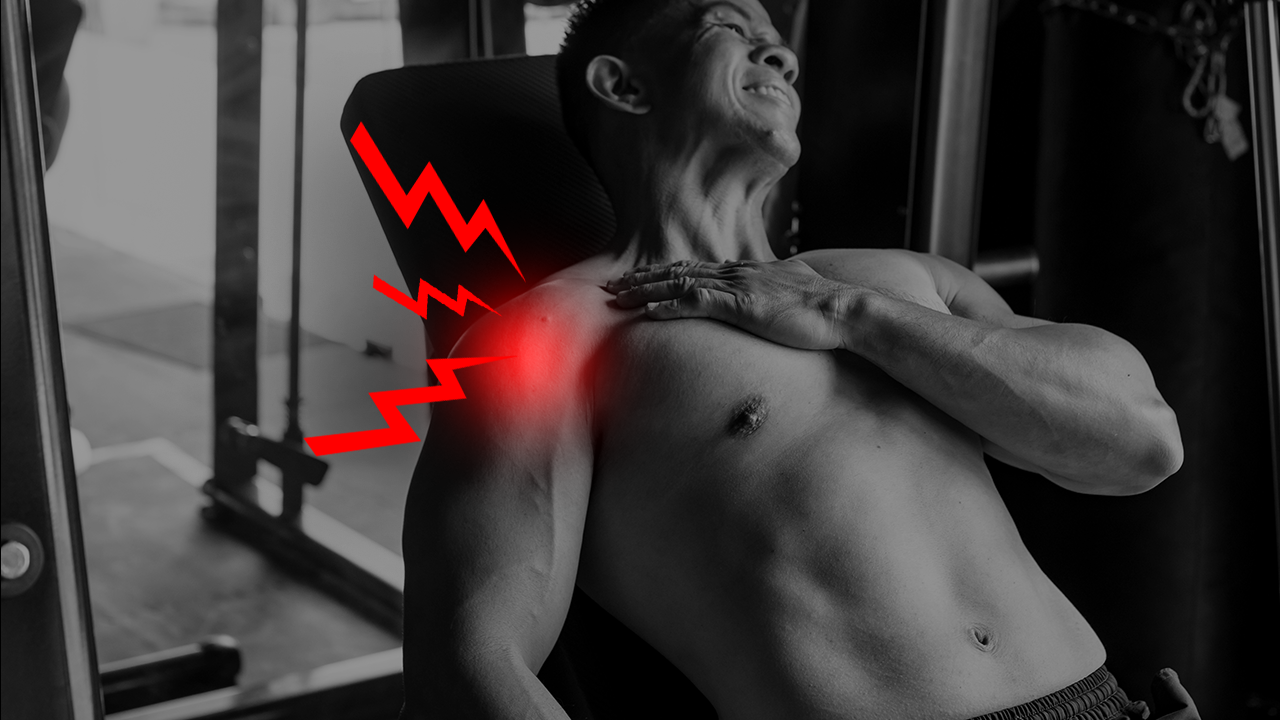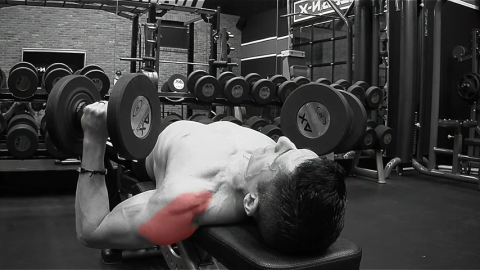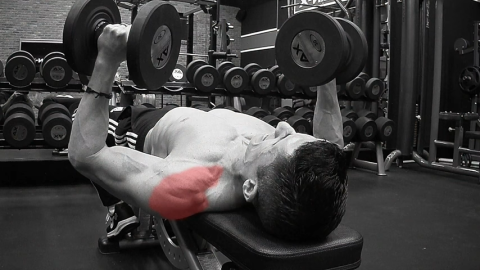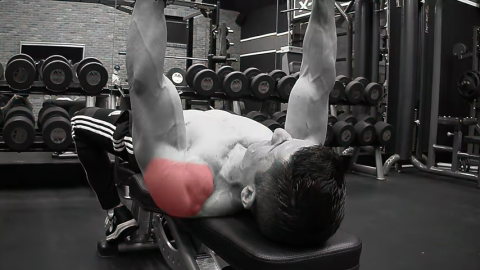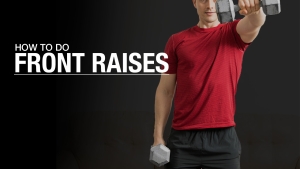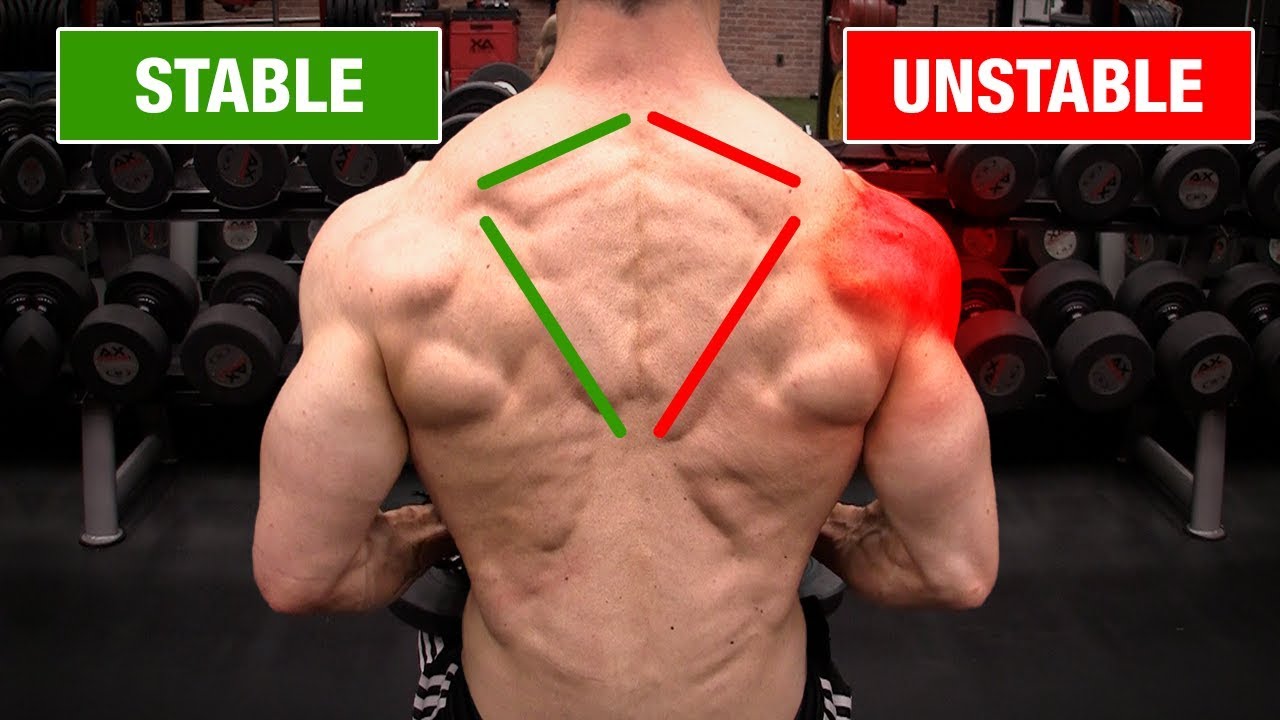
SHOULDER PAIN BENCH PRESS
Picture this: You’re at the gym, pumped and ready to go, when the all-too-familiar sensation of muscle tightness and shoulder pain creeps in during your Barbell Bench Press set.
Does pain after bench press sound familiar? You’re not alone!
There are a ton of people, just like you, that face this pesky dilemma every time chest day rolls around.
But don’t worry, guys, because I’ve got your back (and shoulders)!
Let’s delve deep into the world of shoulder pain during bench pressing, exploring its origins, and providing you with a game-changing solution.
Say goodbye to gritting your teeth through every rep and hello to a pain-free, powerful Bench Press!
ANATOMY OF THE SHOULDERS
Before we jump into breaking down how to avoid shoulder pain bench pressing, let’s take a look at the anatomy of the shoulders.
The shoulder muscles are not a minor muscle group. They have a crucial role in all upper body exercises you do.
Becoming familiar with the shoulder muscles will help you identify where your Bench Press shoulder pain is really coming from and the next steps you have to take.
I’m going to show you the shoulder muscles where you might feel achy pain during the Bench Press exercise or other chest exercises.
REAR DELT
Situated at the back of your shoulder, the posterior deltoid, or rear deltoid muscle, is anchored between the scapula and the humerus bone in your upper arm.

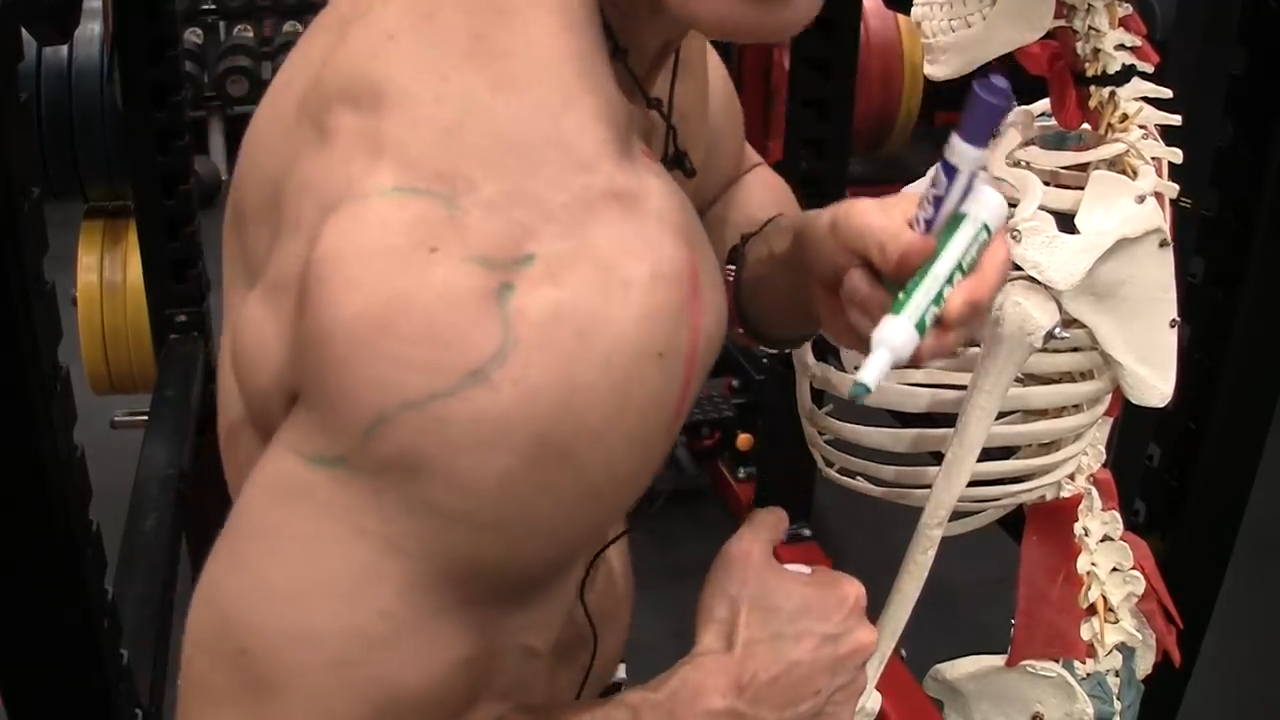
The posterior shoulder muscle takes on three key roles:
- Shoulder extension: Moving your arm backward from the front of your body. Try extending your arm behind you in an upward motion to feel this action.
- Shoulder horizontal abduction: Drawing your arm away from your body’s midline.
- External rotation: Swiveling your arm outward, keeping your elbow tucked by your side.
The rear deltoid also plays a vital part in activating several upper-body muscles during pulling exercises like Pull-Ups, Face Pulls, and Cable Rows.
While executing these movements, the rear deltoid works harmoniously with other back and arm muscles to stabilize and maneuver the shoulder joint, making it an indispensable part of your upper body movements.
MIDDLE DELT
The middle deltoid, or lateral deltoid muscle is positioned on the side of your shoulder.

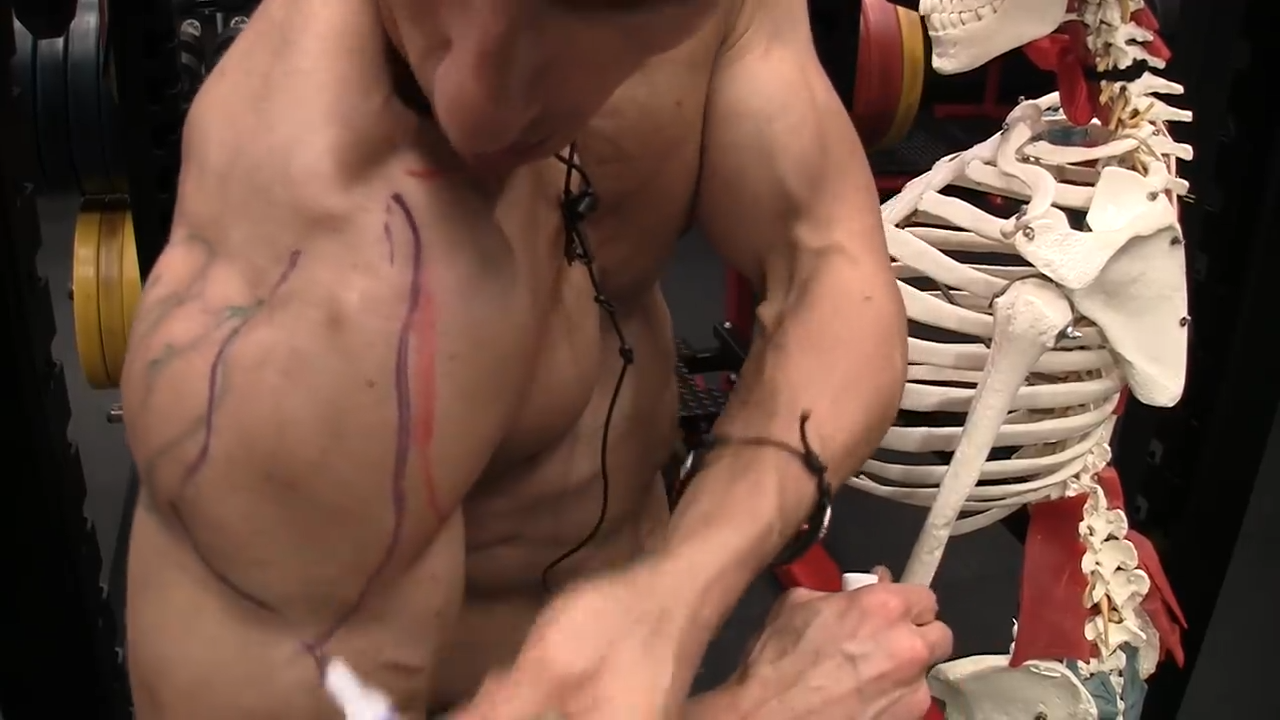
It has three essential functions:
- Shoulder abduction: Lifting your arm away from your body’s midline.
- Shoulder flexion: Bringing your arm forward.
- Shoulder horizontal abduction: Moving your arm outward while keeping your elbow close to your side.
What’s more, the lateral deltoid also lends support to upper body pressing movements such as Overhead Presses and Incline Dumbbell Presses.
Developing robust lateral deltoids is crucial for enhancing overall shoulder strength and aesthetics. While they may not be the first muscles you notice in the mirror, they play a significant role in shaping the width and definition of your shoulder muscles.
To zero in on your lateral delts, incorporate exercises like Dumbbell Rear Lateral Raises into your routine, stimulating muscle growth and paving the way for an impressive, well-defined physique.
FRONT DELT
The front deltoid, or anterior deltoid muscle, graces the front side of your shoulder, connecting your collarbone to the humerus bone in your upper arm.

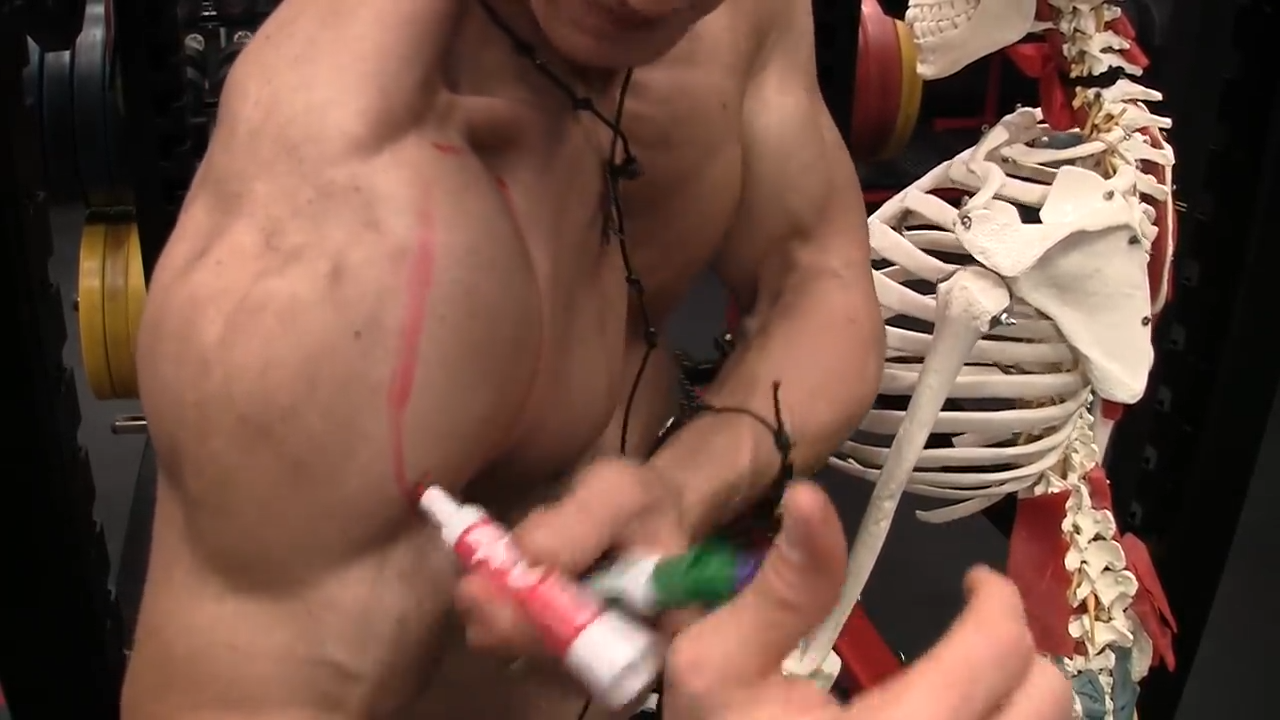
This muscle is responsible for the following:
- Shoulder flexion: Bringing your arm forward.
- Shoulder horizontal adduction: Drawing your arm towards your body’s midline.
- Shoulder internal rotation: Swiveling your arm inward, closer to your body.
As a versatile team player, the anterior deltoid also boosts other upper body pressing exercises such as Push-Ups and Bench Presses, and even supports overhead moves like the Shoulder Press.
To give your front deltoid some extra attention, consider incorporating exercises like Front Raises, Dumbbell Raises, and Bench Presses into your workout routine.
When you feel pain at the bottom of the Bench Press, you’re most likely feeling it in your rear delts.
The biceps tendon that lies in here could get pinched when you enter internal rotation at the bottom of the bench-press.
Also, at the bottom of the movement, the rotator cuff can get pinched inside due to impingement.
And because of its role in stability, that initiation of the press from the bottom is where an unstable rotator cuff is going to come in and be problematic.
MIDDLE OF THE EXERCISE: LATERAL DELTS
When you Bench Press, do you feel more of that twinge and discomfort when you get a little bit away from the bottom, toward midrange?
If so, you are most likely feeling it in your lateral delts.
As you move past midline, where the bicep tendon gets pinched, it could also cause some labrum discomfort.
TOP OF THE EXERCISE: ANTERIOR DELTS
Or maybe you feel the pain at the very end of the Bench Press exercise when you’re lifting the bar straight above you.
If so, you could be feeling it in your anterior delts.
One thing that can get pinched here is the bursae that lays over the top of the shoulder. Let’s not forget that you might be dealing with a muscle tear as well.
Guys, I’m going to tell you this: it doesn’t really matter where you’re feeling it.
You shouldn’t be feeling pain at all when you Bench Press.
A pain-free Bench Press can be tough to accomplish for some people because there are a lot of structures in the shoulder that get involved in the bench-press movement.
But here’s the thing:
If the stability is there, even a damaged structure would be protected.
In terms of the entire balance of the muscle of the shoulder, you should have a centralized humerus.
Meaning, it should stay centralized in the ball-and-socket joint. No matter how you move your arm around, it should be centralized in the shoulder socket.
It shouldn’t migrate up and start to pinch any of those structures.
So, what can you do?
You need to be sure you have the best stability in place.
HOW TO DO A DUMBBELL BENCH PRESS
I have a shoulder test for you, but before I describe what I want you to do, I want to make sure you know what you’re doing when you sit on an adjustable bench.
Below are the best practices for performing the Bench Press:
DUMBBELL BENCH PRESS


HOW TO DO THE EXERCISE: Holding a pair of dumbbells, lie flat on a bench with your feet firmly planted on the ground. Your buttocks and shoulders should be in contact with the bench. The starting position begins with you pinching your shoulder blades together to create some stability. Get your shoulder blades together, and then move them down and back. Initiate that stability and hold that throughout the entire repetition. Extend the dumbbells straight up above your chest. As far as where to move your grip, you don’t want a narrow grip or a wide grip. Instead, keep the elbows at a 45-degree angle as you descend. Slowly lower the dumbbells down until they are close to the sides of your chest. Don’t let them bounce off your chest but get them as close as you can. Pause for a second, then push the dumbbells back up to the starting position.
WHAT MAKES IT EFFECTIVE: The Dumbbell Bench Press is especially effective because it forces each side of the body to contribute equally. When you perform a Barbell Bench Press, you risk masking muscle imbalances because one side might be pushing and lifting more than the other without you realizing. This is eliminated during the Dumbbell Bench Press.
Be aware that the most common Bench Press movement mistakes usually occur because Bench Press technique is bad.
I’d recommend that you practice this exercise with light weight until you master it. Don’t worry about any Bench Press variation like the Decline Bench Press just yet. You’ll get there eventually. We want to fix your body for bench pressing first.
SHOULDER PAIN BENCH PRESS TEST
You know the complete layout of your shoulder muscles, you’ve identified where the pain is coming from, and you know how to do a correct Bench Press.
Now, I want anyone who has shoulder pain to do the following:
Using a standard overhand grip, go grab a lighter set of dumbbells.
Avoid using an improper grip by favoring one side of the dumbbell more than the other. Go right in the middle of the grip on the handle.
Select a lighter weight – a load that is about half as much as what you would normally use for a 10-to 12-rep set on the Bench Press.
If you use a heavy load, you’re going to trigger the excessive strain that’s driving the pain you’ve been feeling. To avoid rotator cuff strain, use a light weight. You can even use resistance bands if you don’t have dumbbells.
I want you to get into the proper Bench Press form mentioned above.
Poor form can be contributing to the Bench Press mechanics that are driving your pain so follow the Bench Press form cues above.
Now, start to press very slowly.
I want you to literally be mindful of every single inch of the press.
The goal is zero pain.
As you move slowly through the movement, notice whether or not you feel any discomfort or pain.

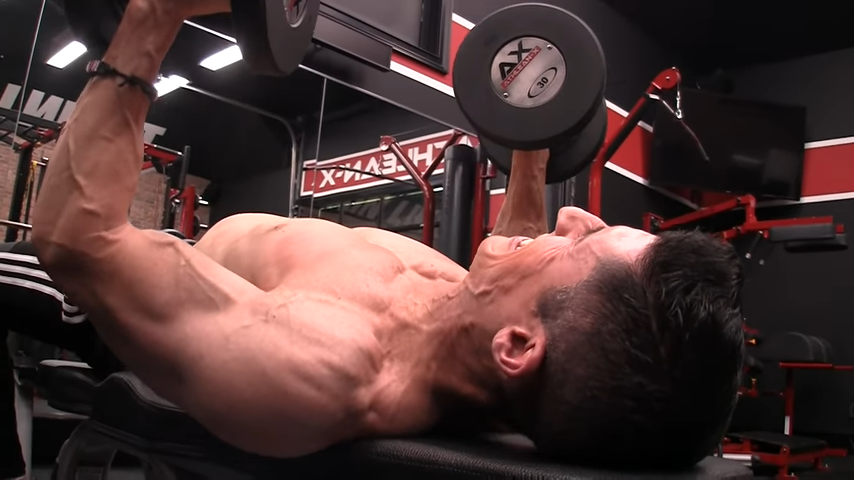
DID YOU FEEL ANY PAIN?
I’m going to guarantee something pretty phenomenal here, guys.
If you performed the test as I said, I will guarantee that 98% of you felt no discomfort or pain.
Why?
Because you’ve just placed stability at the forefront of the exercise.
You’re not focused on the weight you’re pressing. You’re not focused on just getting the resistance off your chest, which is a very dangerous position to be in.
You’re focusing, first and foremost, on the stability of the shoulder joint as you press.
By forcing you to slow down and be mindful of every single inch in that repetition, you prioritized stability in your shoulder.
This moved the tension that would normally be on your shoulder to the pectoral muscles. This is the muscle group activation you want!
HOW TO IMPROVE YOUR BENCH PRESS
What is the purpose of this Bench Press test that I just had you do? Why is this useful?
There are two great reasons you should practice the variables of this test:
DIAGNOSTIC TEST
Number one, as I’ve said, it works as a diagnostic test.
Does it mean you don’t have anything wrong within your shoulder? Not necessarily.
If you’ve been having pain in your shoulder for a while, then you probably have something that needs to be checked out.
It might not be related to injuries, but you could have an issue that needs attention like a strain or certain muscle imbalances.
And it’s better to have that checked out now before it becomes a future injury like a shoulder injury.
But it’s not necessarily that structure that’s causing the pain.
When you slow it down and you stabilize, you’re able to protect that injured structure with the stability of the tissues.
Meaning, regardless of what the issue is here, you can still press without pain because of
the stability that’s protecting that structure.
IMPROVE YOUR BENCH PRESS
If you have Bench Press pain, you’ve got to slow it down and focus on proper form in your training program.
You’ve got to be willing to ditch the heavy weights.
Drop the weight down and work on being able to press pain-free while you work on rehabbing and go back over the weaknesses that cause that.
Try to let the ego drop and work on building up that strength with stability by starting at half the weight you normally “try” to use during a proper Bench Press.
For example, if you normally use 80 pounds during a Dumbbell Bench Press, try starting with 40 pounds. Go slow on each and every rep. As you work on your shoulders, you can utilize progressive overload.
This means slowly – and I mean slowly – going through a gradual increase with the weight you use in your workout program.
Where the instability starts to rear its head is when shoulder pain starts to become a problem.
In addition to focusing on the mechanics of your Bench Press, it’s important to also include these three things to improve the health of your shoulders and rotator cuffs.
- Scapula work
- Rotator cuff exercises
- Face-Pulls
Also, don’t forget about giving yourself appropriate time for recovery.
With these tips and exercises you can work on correcting your shoulder issue without continuing to re-aggravate the inflammation every time you Bench Press.
The goal on Bench Day is to be pain-free. I don’t want you tolerating even a single inch of pain in that range of motion.
Instead, you should work your strength up gradually so you can start to build a solid foundation while you’re working on getting rid of shoulder instability.
If you are looking for a comprehensive program that also helps you to avoid injury, we’ve got you covered. Check out our ATHLEAN-X programs to see which is the best fit for your goals and fitness level.

- You may think you have a justified reason for having shoulder pain during a Bench Press, especially if you have a rotator cuff injury or labrum tear, bursitis, AC joint injury or shoulder impingement.
- While that may be true, that focus on the structure is often undermining your ability to get to the root cause of the problem which is the instability of the shoulder instead.
- The structure (while compromised) can always be protected against further injury if the stability of the shoulder is not compromised.
- The muscles of the scapulae and rotator cuff are there to serve an important function to stabilize the humerus as you perform each rep of the Bench Press. This occurs both on the way up and on the way down on every rep.
- It really isn’t about the structure that is hurting as much as it’s about the fact that it is likely hurting because it is not stabilized by the muscles that should be stabilizing it.
- Here’s what you can do to realize this for yourself and start to train smarter in your Bench Press: Your target weight is half of what you would normally use for a 10-12 rep set taken to failure.
- Start by setting the shoulder blades down and back. Get them here and then focus on keeping them in this stable position from the first rep to the last. As you lift, move very slowly for every rep on the Bench Press.
- You can try to progressively increase your strength in this stabilized position by gradually adding weight to the lift without allowing the onset of pain.
SHOULDER PAIN BENCH PRESS FAQS
Shoulder pain from bench pressing can be caused by a variety of factors, including improper form, muscle imbalances, or pre-existing conditions. To address and alleviate shoulder pain, follow these steps:
- Engage in a proper warm-up routine before bench pressing to prepare your muscles and joints for the activity. Include dynamic stretches and mobility exercises targeting your chest, shoulders, and upper back.
- Incorrect bench press form can contribute to shoulder pain. Ensure that you maintain a neutral spine, retract your shoulder blades, and position your grip width correctly.
- Strengthen the muscles that stabilize your shoulder joints, such as the rotator cuff muscles and the muscles in your upper back, with targeted exercises like Face Pulls, Band Pull-Aparts, and External Rotations.
- Give your shoulders ample time to recover between workouts. If pain persists, consider taking a break from bench pressing and consult a medical professional to rule out any underlying issues.
Yes, bench pressing can cause shoulder pain if done incorrectly or if there is an existing injury or muscle imbalance. Factors that contribute to shoulder pain during bench press include improper form, inadequate warm-up, overuse, or muscle imbalances.
To prevent shoulder pain during bench pressing, follow a well-rounded approach. Start with a thorough warm-up, focusing on chest, shoulders, and upper back.
Prioritize proper form, seeking guidance from a personal trainer or instructional videos if needed.
Strengthen shoulder-stabilizing muscles and incorporate various pressing movements to distribute stress evenly.
Listen to your body, stop the exercise, and consult a medical professional if serious discomfort arises.
These guidelines will help minimize shoulder pain and enhance bench press performance.

Jeff Cavaliere M.S.P.T, CSCS
Jeff Cavaliere is a Physical Therapist, Strength Coach and creator of the ATHLEAN-X Training Programs and ATHLEAN-Rx Supplements. He has a Masters in Physical Therapy (MSPT) and has worked as Head Physical Therapist for the New York Mets, as well as training many elite professional athletes in Major League Baseball, NFL, MMA and professional wrestling. His programs produce “next level” achievements in muscle size, strength and performance for professional athletes and anyone looking to build a muscular athletic physique.
















